 Khasan
Lake Khasan
Lake

|
- Soldier of the Pos'yet Frontier Guards Detachment of the
NKVD troops of the USSR. He is armed a 7.62mm Mosin-designed
rifle of the 1891/1930 model. His cartridge pouches are of a
pre-revolutionary model (they refer to times before 1917). One
can see supporting shoulder belts as part of the arming. The
service coat has a low-cut welt strip with three buttonholes
according to the NKVD model. The service cap has a dark-green
top, its cap band being of a very dark shade of blue bordering
on black colour, and crimson piping. On the service coat one
can see a "Voroshilov marksman" badge. Vicinity of
Lake Khasan. July 1938. [2]
- Squad leader of the Red Army's 2nd Mechanised Brigade that
belonged to the 39th Rifle Corps. The service cap is gray with
black worsted cap band and red piping, the arming is of
standard type. The squad leader is armed with a 7.62mm Nagant-designed
revolver of the 1895 model. He is holding a signal flag in his
hand. Fixed on his service coat is a "Ready for work and
defense" badge. Vicinity of Lake Khasan. August 1938. [2]
|
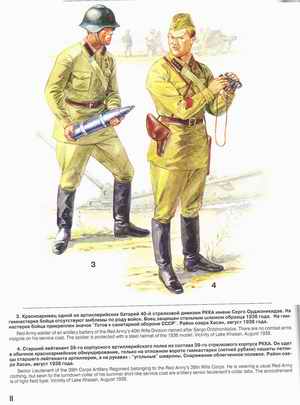
|
- Red Army soldier of an artillery battery of the Red Army's
40th Rifle Division named after Sergo Ordzhonikidze. There are
no combat arms insignia on his service coat. The soldier is
protected with a steel helmet of the 1936 model. Vicinity of
Lake Khasan, August 1938. [2]
- Senior Lieutenant of the 39th Corps Artillery Regiment belonging
to the Red Army's 39th Rifle Corps. He is wearing a usual Red
Army clothing, but sewn to the turndown collar of his summer
shirt-like service coat are artillery senior lieutenant's collar
tabs. The accoutrement is of light field type. Vicinity of Lake
Khasan, August 1938. [2]
|

|
- Squad leader of the Red Army's 32nd Saratov Rifle Division.
He is armed with a 7.62mm Mosin-designed rifle of the 1891 model.
Besides a standard set of accoutrement, he has a knapsack and
a greatcoat roll over his shoulder. On his steel helmet of the
1936 model there is a special net for using plant branches as
camouflage. Vicinity of Lake Khasan, August 1938. [2]
- Infantry Lieutenant of the 78th Kazan Holding the Order
of the Red Banner Rifle Regiment of the 26th Zlatoust Holding
the Order of the Red Banner Rifle Division. The officer is protected
with a steel helmet of the 1936 model, his accoutrement is of
the 1932 model. The sides of his collar and the cuffs of his
service coat are piped with crimson worsted, which signifies
that he belongs to infantry commanders and chiefs. His service
coat is decorated with the Order of the Red Star. Combat operations
area near Lake Khasan. August 1938. [2]
|

|
- The Red Army's Air Force captain belonging to the 36th Fighter
Air Regiment of the Soviet troops. He is wearing a leather raglan
coat and a blue Air Force service cap introduced in 1938. Vicinity
of Lake Khasan, August 1938. [2]
- The Red Army's Air Force lieutenant wearing a version of
the Soviet aviation's summer flying suit. As a rule, collar
tabs were not sewn to such flying suits. The 55th Mixed Bomber
Air Regiment, vicinity of Lake Khasan, August 1938. [2]
|
 Khalkhin-Gol (Nomonhan) Khalkhin-Gol (Nomonhan)
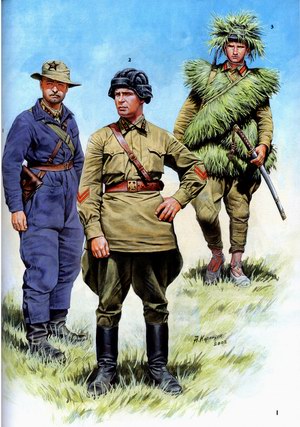
|
- Platoon commander's assistant. The 11th Tank Brigade. He is weared in coveralls and uniform panama. July, 1939
- Tank company commander of the 6th Tank Brigade. He is weared in summer field dress and crash tank helmet. August, 1939.
- Scout of the Reconnaissance Battalion of the 11th Tank Brigade. He is weared in self-made «grassy» camouflage and rubber sporting slippers. There is a trophy Japanese swardm his hand. July, 1939. [4]
|
 Baltic
Area 1941 Baltic
Area 1941
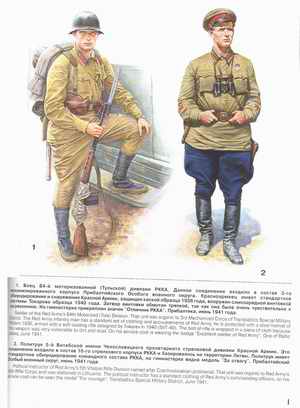
|
- Soldier of the Red Army's 84th Motorized (Tula) Division
That unit was organic to the 3rd Mechanised Corps of Baltic
Special Military District. The Red Army infantry man has a standard
set of clothing and accoutrements of Red Army, he is protected
with a steel helmet of Pattern 1936, armed with a self-loading
rifle designed by Tokarev in 1940 (SVT-40) The bolt of rifle
is wrapped in a piece of cloth because IBS weapon was very vulnerable
to dirt and dust. On his service coat is wearing the badge "Excellent
soldier of Red Army". One of Baltic states, June 1941 [3]
- Political instructor of the Red Army's 5th Vitebsk Rifle
Division named after Czechoslovakian proletariat. That unit
was organic to the Red Army's 16th Rifle Corps and was stationed
in Lithuania. The political instructor has a standard clothing
of Red Army's commanding officers, on his service coat can be
seen the medal "For courage". Baltic Special Military
District. June 1941.
|
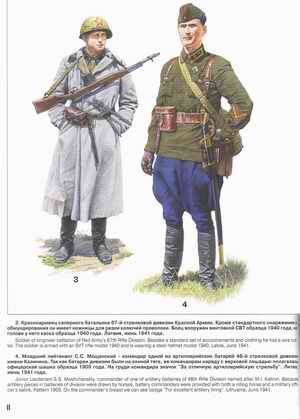
|
- Soldier of sapper battalion of the Red Army's 67th Rifle
Division. Besides a standard set of accoutrements and clothing
he has a wire cutter. The soldier is armed with an SVT rifle
model 1940 and is wearing a steel helmet model 1940. Latvia,
June 1941. [3]
- Junior Lieutenant S.S. Moshchanskiy, commander of one of
artillery batteries of the M.I. Kalinin 48th Rifle Division.
Because artillery pieces in batteries of division were drawn
by horses, battery commanders were provided with both a riding
horse and a military officer's sabre, Pattern 1909. On the commander's
breast we can see badge "For excellent artillery firing".
Lithuania. June 1941. [3]
|
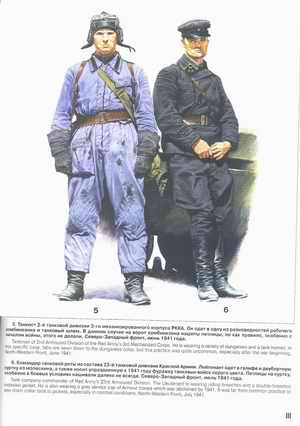
|
- Tanker of the 2nd Tank Division of the Red Army's 3rd Mechanised
Corps. He is wearing a variety of dungarees and a tank helmet,
in this specific case, tabs are sewn down to the dungarees collar,
but this practice was quite uncommon, especially after the war
beginning. North-Western Front. June 1941 [3]
- Tank company commander of the Red Army's 23rd Tank Division.
The Lieutenant is wearing riding breeches and a double-breasted
moleskin jacket. He is also wearing a gray service cap of Armour
troops which was abolished by 1941. It was far from common practice
to sew down collar tabs to jackets, especially in combat conditions.
North-Western Front. July 1941.[3]
|
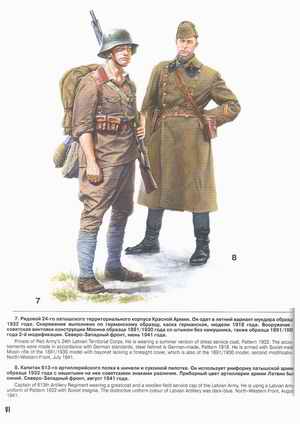
|
- Private of Red Army's 24th Latvian Territorial Corps. He
is wearing a summer version of dress service coat, Pattern 1932.
The accoutrements were made in accordance with German standards,
steel helmet is German-made. Pattern 1918. He is armed with
Soviet-made Mosin rifle of the 1891/1930 model with bayonet
lacking a foresight cover, which is also of the 1891/1930 model,
second modification North-Western Front. July 1941.[3]
- Captain of the 613th Artillery Regiment wearing a greatcoat
and a woollen field service cap of the Latvian Army. He is using
a Latvian Army] uniform of Pattern 1932 with Soviet insignia.
The distinctive uniform colour of Latvian Artillery was dark-blue.
North-Western Front. August 1941[3]
|

|
- This soldier of Red Army's 29th Lithuanian Territorial Corps
is wearing summer version of full-dress coat, Pattern 1930.
The collar on such a coat was to be upright, but photographs
of Lithuanian soldiers from 29th Corps show also turn-down collars
with Soviet tabs sewn down on them. The distinctive uniform
colour of Lithuanian Infantry was yellow. Soldier is armed with
a Lithuanian made Mauzer L. rifle Northwestern Front, July 1941.[3]
- Lieutenant commanding a cavalry scout platoon of Red Army's
22nd Estonian Territorial Corps. He is wearing a full-dress
cavalry coat. Pattern 1936, red riding breeches and high cavalry
boots authorized for wear in Estonian cavalry. The sabre is
Estonian, Pattern 1925. The service cap is of Red Army combined-arms
type. Pattern 1936. The insignia correspond to Soviet standards.
North-Western Front, July 1941. [3]
|
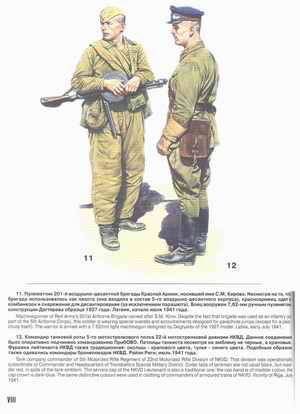
|
- Machine gunner of Red Army's S.M. Kirov 201st Airborne Brigade.
Despite the fact that brigade was used as an infantry (as a part
of the 5th Airborne Corps), this soldier is wearing special
overalls and accoutrements designed for parachute jumps (except
for a parachute itself). The warrior is armed with a7.62rnm
light machine-gun designed by Degtiarev of the 1927 model. Latvia,
early July 1941.[3]
- Tank company commander of the 5th Motorized Rifle Regiment/22nd
Motorized Rifle Division of NKVD. That division was operationally
subordinate to Commander and Headquarters of the Baltic Special
Military District. Collar tabs of tanker are not usual black,
but madder red, in spite of the tank emblem. The service cap
of the NKVD Lieutenant is also a traditional one: the cap band
is of madder colour, the cap crown is dark-blue. The same distinctive
colours were used in clothing of commanders of armoured trains
of NKVD. Vicinity of Riga, July 1941.[3]
|
 Vyazma
1941 Vyazma
1941
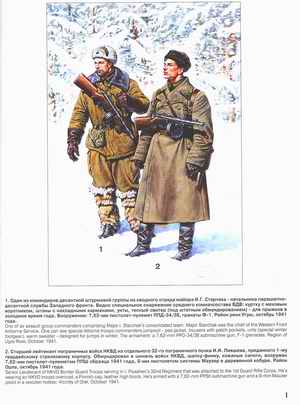
|
- One of air assault
group commanders comprising Major I. Starchak's consolidated
team. Major Starchak was the chief of the Western Front Airborne
Service. One can see special Aiborne troops commanders jumpsuit
- pea jacket, trousers with patch pockets, unts (special winter
footgear), warm sweater - designed for jumps in winter. The
armament: a 7.62-mm PPD-34/38 submachine gun, F-1 grenades.
Region of Ugra River, October 1941.
- Senior Lieutenant of NKVD Frontier Guard Troops serving
in the I. Piyashev's 32nd Frontier Guards Regiment that was
attached to the 1st Guard Rifle Corps. He's wearing an NKVD
troops overcoat, a Finnish cap. leather high boots. He's armed
with a 7,62-mm PPSh submachine gun and a 9-mm Mauzer pistol
in a wooden holster. Vicinity of Orel, October 1941. [1]
AMVAS - according to other data Lt. Col. Piyashev in that period was the 34th NKVD Motorised Rfl. Regt. commander |
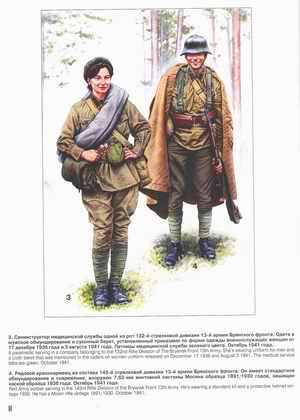
|
- A paramedic serving in a company belonging to the 132nd
Rifle Division/13th Army of the Bryansk Front . She's wearing
uniform for men and a cloth beret that was mentioned in the
orders on women uniform released on December 17, 1936 and August
3, 1941, The medical service tabs are green. October 1941.
- Red Army soldier serving in the 143rd Rifle Division/13th
Army of the Bryansk Front . He's wearing a standard kit and
a protective helmet vintage 1936. He has a Mosin rifle vintage
1891/1930. October 1941. [1]
|
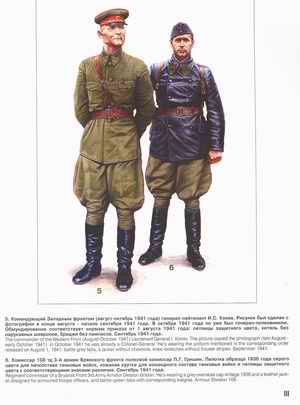
|
- The commander of the Western Front (August-October 1941)
Lieutenant General I. Konev. The picture copied the photograph
(late August -early October 1941). In October 1941 he was already
a Colonel-General. He's wearing the uniform mentioned in the
corresponding order released on August 1. 1941: battle gray
tabs, a jacket without chevrons, knee-breeches without trouser
stripes. September 1941. [1]
- Regimental commissar Grishin of the 108th Tank
Division/3rd Army of the Bryansk Front. He's wearing a
gray overseas cap vintage 1936 and a leather jacket designed
for armoured troops officers, and battle-green tabs with corresponding
insignia. [1]
|
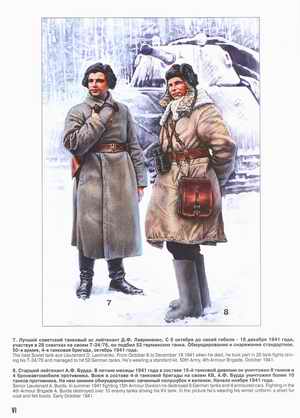
|
- The best Soviet tank ace Lieutenant D. Lavrinenko. From
October 6 to December 18 1941 when he died, he took part in
28 tank fights driving his T-34/76 and managed to hit 52 German
tanks. He's wearing a standard kit. 50th Army. 4th Armour Brigade.
October 1941.[1]
- Senior Lieutenant A. Burda. In summer 1941 fighting in the
15th Tank Division he destroyed 8 German tanks and 4 armoured
cars. Fighting in the 4th Tank Brigade A. Burda destroyed over
10 enemy tanks driving his KV tank. In the picture he's wearing
his winter uniform: a short fur coat and felt boots. Early October
1941.[1]
|
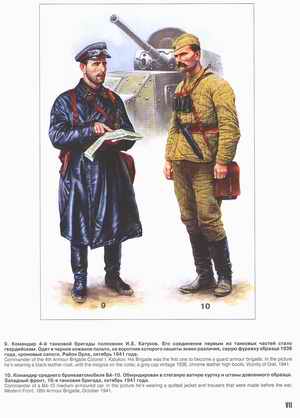
|
- Commander of the 4th Tank Brigade Colonel I. Katukov.
His Brigade was the first one to become a guards tank brigade.
In the picture he's wearing a black leather coat, with the insignia
on the collar, a gray cap vintage 1936, chrome leather high
boots. Vicinity of Orel, 1941. [1]
- Commander of BA-10 medium armoured car. In the picture
he's wearing a quilted jacket and trousers that were made before
the war. Western Front, 18th Tank Brigade. October 1941.
[1]
|
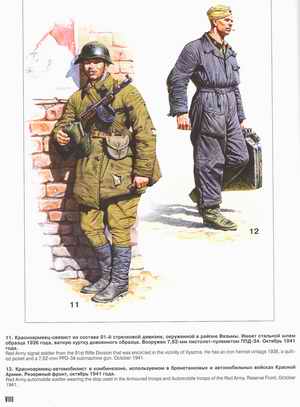
|
11. Red Army signal soldier from the 91st Rifle Division that
was encircled in the vicinity of Vyazma. He has an iron helmet vintage
1936, a quilted jacket and a 7.62-mm PPD-34 submachine gun. October
1941. [1]
12. Red Army automobile soldier wearing the slop used in the
Armoured troops and Automobile troops of the Red Army. Reserve Front.
October 1941. [1] |
 The Caucasus 1942-43 The Caucasus 1942-43
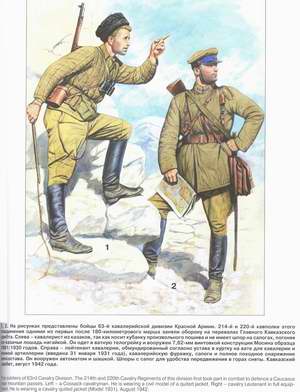
|
The soldiers of the 63rd Cavalry Division. The 214th and 220th Cavalry Regiments of this division first took part in combat to defence a Caucasus near mountain passes.
- Left - a Cossack cavalryman. He is wearing a civil model of a quited jacket.
- Right - cavalry Leutenant in full equipment. He is wearing a cavalry quited jacket (Model 1931). August 1942. [5]
|
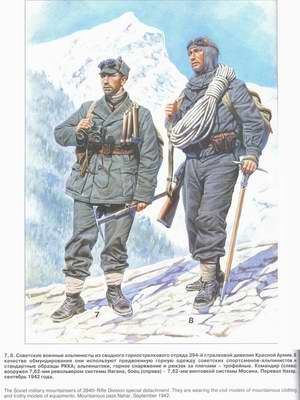 |
The Soviet military mountaineers of 394th Rifle Division special detachment. They are wearing the civil models of mountainous clothing and trothy models of equipments. Mountainous pass Nahar, September 1942. [5] |
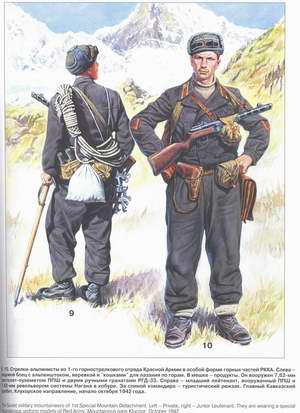 |
IltieSoviet military mountaineers of 1st Special Mountain Detachment.
- Left - Private,
- right - Junior Leutenant.
They are wearing a special mountainous uniform models of Red Armv. Mountainous oass Kluchor. October 1942.[5] |
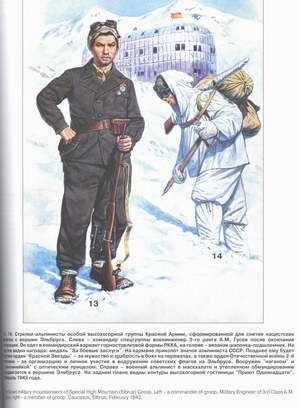 |
The Soviet military mountaineers of Special High Mountain (Elbrus) Groop.
- Left - a commander of groop, Military Engineer of the 3rd Class A.M. Gusev
- Right - a member of groop.
Caucasus, Elbrus, February 1943. [5] |
|
|


